The Electronic Intifada 26 August 2020

Israel has used drones to cause huge destruction in Gaza.
APA imagesIyad Ghanem has heard Israel’s drones flying overhead for most of his life.
Like many other people in Gaza, he refers to these pilotless warplanes as crows. The noise they make is often called zanana, the Arabic word for buzzing.
Whenever he hears a drone, Ghanem says “the crow has come and there will be no sleep tonight.”
“I feel that someone is watching me,” the 18-year-old said. “I feel anxious when the sound gets louder, as if something terrible is going to happen.”
Ghanem can remember Israel’s November 2012 attack on Gaza “in all its detail,” he said. Drones were used heavily during that week-long offensive, when approximately 160 Palestinians were killed.
Hearing drones above brings back painful memories of that attack. “Drones cause terror to this very day,” Ghanem added.
Drones have been a prominent weapon for Israel at least since 2006, when it attacked Lebanon. They are used for reconnaissance and, on occasion, as killing machines.
Infamous
Israel has dropped bombs from drones during the three major offensives it has waged on Gaza since December 2008.
The Israeli weapons industry has tried to take advantage of those operations by marketing its drones and other weapons as “battle proven.”
Experimenting on Palestinians has proven lucrative. According to data published in 2019, Israel has become the world’s largest exporter of drones.
Israel’s drone exports were worth more than $4.6 billion over an eight-year period, according to the data, which was gathered by the consulting firm Frost & Sullivan.
Drones became infamous for “roof knocking” during a major Israeli attack on Gaza in 2014. That was a euphemism for how bombs were dropped from drones on civilian buildings as a “warning” of a more powerful blast.
Israel sought to imply that “roof knocking” was a humane gesture to protect civilians by warning them in advance that their homes would be destroyed. In practice, civilians were often not given enough time to evacuate before the deadlier explosion occurred, as a United Nations fact-finding mission confirmed.
Drones were used during some particularly horrific episodes of the attack six years ago.
Adham Shakhsa is a 40-year-old living in al-Shujaiyeh, a neighborhood of Gaza City where Israel carried out a massacre during the 2014 offensive.
“Three days before the massacre, there were drones hovering in the sky above al-Shujaiyeh,” he said. “We could see them with the naked eye and they were very loud. We have become used to this situation during Israel’s wars. I realized that Israel used drone technology to observe people in the neighborhood before the massacre.”
Another al-Shujaiyeh resident, Anas al-Madhoun, points out that Gaza’s children know more about military belligerence than their peers in most other countries. At an early age, they learn to distinguish between the sounds of drones and those made by other weapons in Israel’s arsenal, notably US-made Apache helicopters and F-16 jets.
“It is incredible to hear Israel defending itself before the international media,” al-Madhoun said. “It is incredible to hear Israel claiming that it doesn’t besiege Gaza, that it is just protecting itself.”
Constant surveillance
Drones can be heard frequently over Gaza’s skies in supposedly more peaceful times – when Gaza is subject to a blockade rather than a blitz. Drones serve as a reminder that Palestinians are under constant surveillance.
Mahmoud Siyam, a psychiatrist, argues that Israel is, in effect, torturing Gaza’s people by monitoring them with drones.
Humans require calmness and relaxation. Deprived of these essential needs, their mental health can be damaged.
Hearing drones “puts psychological pressure on everyone,” said Siyam. “The noise of drones makes people irritable. People may feel extreme anxiety and lose their ability to concentrate.”
Israel began subjecting Palestinians to drone flights after withdrawing settlers from Gaza in 2005. The withdrawal meant that Israel’s occupation was moved to the periphery and that Israel’s brutality against Gaza’s people continued and, in many ways, intensified.
Iman al-Mansi lives on the ninth floor of a tower block in the Tel al-Hawa area of Gaza City. Drones prevent her and her family from leading a normal life.
“The sound of drones is very loud,” she said. “We cannot sleep when we hear them. We cannot watch television. When there is a drone near us, it always interferes with satellite reception. We have been living like this since 2006.”
Ahmad al-Husari, who lives in al-Zaytoun, also a Gaza City neighborhood, often gets a headache from the sound of drones.
“Sometimes the drones are so noisy they are like a car’s engine getting louder as the driver gets faster,” he said. “The drones make my children wake up and then they cannot go back to sleep. Sometimes I hate evenings because of all this noise.”
Amjad Ayman Yaghi is a journalist based in Gaza.





